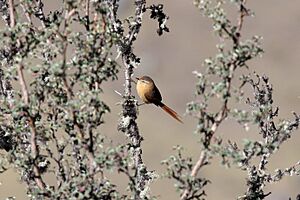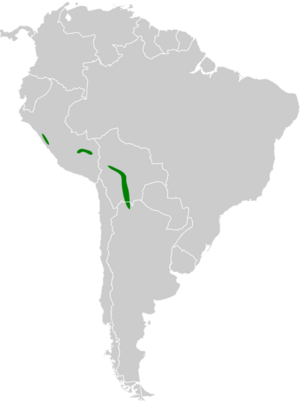Tawny tit-spinetail facts for kids
Quick facts for kids Tawny tit-spinetail |
|
|---|---|
 |
|
| Conservation status | |
| Scientific classification | |
| Genus: |
Sylviorthorhynchus
|
| Species: |
yanacensis
|
 |
|
The tawny tit-spinetail (its scientific name is Sylviorthorhynchus yanacensis) is a small bird. It belongs to the ovenbird family called Furnariidae. You can find this bird in Argentina, Bolivia, and Peru.
Contents
About the Tawny Tit-Spinetail
How Scientists Classify This Bird
When scientists first found the tawny tit-spinetail, they put it in a group called Leptasthenura. But in 2011, new studies on its DNA showed it actually belongs in the group Sylviorthorhynchus.
It shares this group with another bird called the Des Murs's wiretail. These two birds are like close relatives in the bird world. The tawny tit-spinetail is the only type of its kind, meaning there are no different subspecies.
What Does the Tawny Tit-Spinetail Look Like?
The tawny tit-spinetail is about 16 to 17.5 cm (6.3 to 6.9 in) long. That's about the length of a pencil! It weighs around 10 to 12 g (0.35 to 0.42 oz), which is very light. Both male and female birds look the same.
Their face is a bright cinnamon color. Their forehead is a reddish-brown, and the top of their head is tawny brown. Birds from Peru have a thin, light stripe above their eye. Bolivian birds have a similar stripe, but it's whitish.
Their back is tawny brown, and their rump (the lower back) is rufous, which is a reddish-brown color. Their wings are dark with rufous edges. Their tail is rufous and gets longer towards the middle. Their belly and chest are bright cinnamon.
Their eyes are brown, and their beak is dark brown or black. Their legs and feet are dark gray or black.
Where Does the Tawny Tit-Spinetail Live?
The tawny tit-spinetail lives in different areas that are not connected. One group lives in the Cordillera Blanca mountains in Peru. Another group is found in southern Peru. A third group lives from northern Bolivia down into northwestern Argentina.
These birds mostly live in forests with special trees called Polylepis. They also live in mountain scrublands and some grasslands. They prefer high places:
- In Peru, they live between 3,950 and 4,600 m (13,000 and 15,100 ft) high.
- In Bolivia, they live between 2,800 and 4,200 m (9,200 and 13,800 ft) high.
- In Argentina, they live between 2,900 and 3,600 m (9,500 and 11,800 ft) high.
Tawny Tit-Spinetail Behavior
Movement
The tawny tit-spinetail stays in the same area all year round. It does not migrate to different places.
Feeding Habits
We don't know all the details about what the tawny tit-spinetail eats. But we do know it mostly eats small arthropods, like insects or spiders. It also eats a little bit of plant material.
These birds usually look for food in pairs or small family groups. They often join other types of birds to hunt together. They find their food by picking it off leaves, small branches, and tree bark. Sometimes, they even hang upside down to reach their prey! They also look for food on the ground.
Reproduction and Life Cycle
Scientists don't know exactly when the tawny tit-spinetail's breeding season is. But they have seen them nesting in November and December. Only one nest has ever been found.
This nest was shaped like a ball and made of grass stems. It had a small opening on the side. Inside, it was lined with soft plant fibers and feathers. The nest was built in the fork of a Polylepis tree, about 2.5 m (8 ft) above the ground. Both the male and female birds helped build it. We don't know much else about how they raise their young.
What Sounds Do They Make?
The tawny tit-spinetail has a special song. It's a fast series of loud, sharp "chips" that speed up into a chattering sound. It sounds like: tchp tchp tchp-tchi'tchi'tchi'tchi'tchi'tchi-tchp.
They also make other sounds, like various chatters: tjiketjitjitjitjitjitjit-t-t-t. They make short notes like t-t-tjk-tjketjketjketjketjk-tjk, rrrip rrrip tjktjktjke rrhie tjktjke. Sometimes you might hear a short, snarling "eep" or quiet, soft "tchp" notes.
Conservation Status
The IUCN (International Union for Conservation of Nature) keeps track of how many animals are left in the world. In 1988, they thought the tawny tit-spinetail was "Near Threatened." But in 2016, they changed its status to "Least Concern." This means it's not currently in danger of disappearing.
The bird lives across a large area. Scientists believe there are at least 50,000 adult birds. However, this number might be going down. The biggest problems for these birds are too much grazing by farm animals and uncontrolled fires. These issues stop the Polylepis trees from growing back. People also cut down these trees for wood, firewood, and charcoal, which further harms their habitat.


